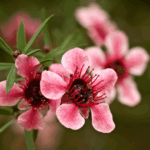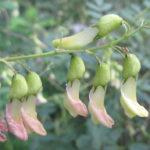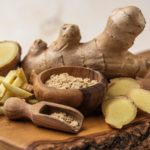
Kate McCullough
BA (Ayurveda Wellness and Integrative Health)
In this article we are going to talk in detail about the Kapha dosha, which is composed of the earth and water elements.
Earth and water have heavy, oily, cold, stable, sweet and sticky qualities, so some common characteristics related to Kapha are reflections of these, such as
- Larger body frame
- Oily skin
- Soft facial features
- Thick, dark and long hair
- Great strength and endurance
Having a better understanding of each of the doshas and how to keep them balanced within our physiology and psychology can help us stay healthy and free from diseases.
Let’s see how we can do that.
What are the doshas?
The three doshas or bodily humours; Vata, Pitta and Kapha are known as the governing principles of nature in Ayurveda. These doshas are each made up of a different combination of the five elements:
- Space
- Air
- Fire
- Water
- Earth

Vata is predominantly made up of air and space, Pitta is a combination of water and fire, and Kapha is represented by water and earth.

If you have just started your reading journey on doshas, we suggest you also check Vata imbalance — Are you always worried, anxious and cold?
Kapha’s function in the body
Like all three doshas, Kapha is present everywhere in nature, but is most commonly found in areas where there are more Kapha qualities such as mud, which has heavy, stable, moist, and soft qualities.
Kapha (earth) is responsible for governing things like lubrication, cohesion and structure within our environment and our bodies.[1]
In the body, Kapha’s main function is to provide structural integrity, giving the body its weight, body mass and stability.
Kapha is stability, endurance, calmness, growth and cohesion
Other important functions in the body governed by Kapha is lubrication of all our joints and organs and the strength of our muscles and bones.[2]
Kapha also controls the regulation of cellular secretions.[2]
Qualities of Kapha
Kapha is composed of the earth and water elements, giving it the following qualities
- Oily
- Heavy
- Cold/moist
- Stable
- Dull
- Sweet
- Slow
- Sticky
Qualities such as heavy, slow and dull, means that Kapha individuals easily become lazy and hard to motivate to make changes when out of balance.
There are more Kapha qualities in nature during the spring season, as it is a time when the environment begins to blossom and create new life.
If we drift from our connection with nature during spring time and continue living as if we are in winter, like eating heavy foods and being more sedentary, then we are likely to experience a Kapha imbalance which manifests as sluggishness and heaviness.[3]
Characteristics of Kapha

Kapha mind-body types are naturally big-hearted and nurturing individuals.
They have a sweet and loving nature.[4]
When balanced, Kaphas are very devoted, caring and supportive friends who will always welcome you into their home with open arms, and lend you a shoulder to cry on.[5]
While sometimes slow to grasp new information, they do have great long term memories.
In other words, once they learn something they’ll never forget it.[6]
Other characteristics of Kapha types include
- Solid, heavier body frame
- Supportive
- Compassionate
- Slow, calm mind
- Strong
- Talk slower
- Detail oriented
- Tendency for oily skin
- Tendency towards slow digestion
- Deep sleepers
Kapha, like all three doshas, has many beautiful qualities when they are in a balanced state, which is why it’s important to learn about Kapha and its nature to maintain this balance.
Signs of a balanced Kapha
- Loving
- Generous
- Loyal
- Deep sleep
- Emotionally stable
- Strong stamina
- Balanced breathing (no congestion)
- Balanced elimination (not too slow)[7]
Kaphas are supportive and kind-hearted people
Each dosha’s unique strengths when they are in a balanced state is what allows us to have amazing diversity and co-operation within our society.
Signs of an imbalanced Kapha
For individuals that have a predominately Kapha mind-body, or Kapha combination mind-body type, they are more prone to experiencing imbalances related to excess Kapha.
These imbalances typically manifest as
- Laziness or fatigue
- Fluid retention
- Asthma
- Obesity
- Greediness
- Depression
- Stubbornness
- Excess mucus
- Excessive sleep
- Sluggish digestion/metabolism
- Prone to colds/flu/sinus congestion
- Hay fever/seasonal allergies[8]

The key to helping a Kapha achieve balance again is through patience and motivating them to make small changes at a time.
Causes of Kapha imbalances
In Ayurveda, a dosha imbalance is caused by the notion of “like increases like” (Samanya), therefore the more Kapha qualities in our life, the higher the chances are of experiencing a Kapha imbalance.
RELATED — Introduction to Ayurveda: Ancient medicinal healing methods
Spring is the season of Kapha, as there are more Kapha qualities in the environment as nature blossoms and creates new life.
This reflects in our minds and bodies as a time for a fresh start, and a desire to clean and detoxify our environment and physiology.[3]
RELATED — Why we sleep: The role of sleep in our healthy life
The most common factors that cause a Kapha imbalance are
- Heavy, oily, moist foods
- Overeating, or eating late at night
- Cold/rainy/humid weather
- Lack of movement/exercise
- Oversleeping, or day time sleeping
- Lack of mental stimulation[9]
The more Kapha qualities in one’s life, the more likely they will become imbalanced
How to balance Kapha
While diet is a big factor when it comes to balancing Kapha, we also need to take into consideration the lifestyle and daily habits to gain true balance.
The easiest way to balance Kapha is to increase movement, have a stable daily routine (regular wake times and bedtimes) and to favour a more light, fresh and easy-to-digest diet.
Prioritising exercise can be a game changer for individuals experiencing a Kapha imbalance. Exercising helps to decrease Kapha’s heaviness, clear the mind and energise the body.[10]
Exercises beneficial to Kapha body types are ones that are fun and challenging like hiking, running, weightlifting, cycling, and vigorous yoga.[11]
Five key words to focus on when balancing Kapha are:
- Stimulation
- Exercise
- Lightening
- Warming
- Drying[12]
Foods to consume
Foods that are bitter, astringent and pungent will help, such as
- Warm herbal/digestive teas (ginger, cinnamon, peppermint)
- Barley, buckwheat, corn, quinoa, rye
- Black beans, lentils, mung beans, tofu
- Buttermilk, goat’s milk, cottage cheese
- Honey
- Ghee, sunflower oil
- Apples, pears, berries, mango, peaches
- Leafy greens, broccoli, beans, cauliflower, tomatoes, potatoes
- Almonds, chia seeds, sunflower seeds, pumpkin seeds
- Cinnamon, ginger, black pepper, cardamon, cloves, cumin
- Chicken, eggs, fish, turkey, venison (if not vegetarian)[13]

Foods to avoid and reduce
Foods that should be avoided in case of a Kapha imbalance, are foods that are naturally sweet, salty and sour.
- Cold drinks, alcohol, soda
- Oats, pasta, rice, wheat
- Soy beans, kidney beans
- Banana, coconut, melons, dates, grapes
- Kumara, pumpkin, zucchini, cucumber, avocado
- Butter, cheese, milk, ice cream, sour cream
- All nuts (except almonds)
- Avocado oil, coconut oil, sesame oil, olive oil
- Artificial sweeteners, white sugar, maple syrup
- Salt (in excess)
- Beef, duck, salmon, lamb, pork[13]
Lifestyle complementing balanced Kapha
Lifestyle is an important factor when it comes to balancing Kapha. Having a regular routine, especially wake times and bedtimes, helps Kapha to stay balanced and energized.
The times of day when Kapha is more lively in the environment is from 6am–10am and 6pm–10pm, therefore this is when we should avoid activities that increase Kapha like sleeping and eating heavy foods.
Other lifestyle factors to help balance Kapha are
- Rising before 6am (sleeping in will increase Kapha qualities within you like heaviness and sluggishness)
- Exercising between 6–10am and working up a good sweat
- Sipping warm water and herbal digestive teas during the day, especially during winter and spring
- Keeping dry and warm
- Listening to lively and invigorating music
- Mind stimulation
- Self-massage (abhyanga) with warm mustard oil
- Trying new things, getting out of your comfort zone, challenging yourself[12,14]
Exercise and Kapha
Kapha is a body type that most likely avoids exercising because of their heavy sluggish nature. We can help this by selecting exercises that provide a good challenge and that Kapha will find exciting.[15]
This could include weightlifting, basketball, martial arts, cycling, tennis, volleyball and other team sports.[15]
Exercising right after rising in the morning (between 5:30am – 6:30am) is the best time for a Kapha person since it will stimulate their sluggishness, giving them energy for the day.
Herbs that help to balance Kapha
Triphala supports healthy daily elimination, which can help reduce a build up of toxins.[16]
Tulsi supports a healthy immune system alongside the upper respiratory tract and lungs. It has warm, light and clarifying properties which is perfect for balancing Kapha.[17]
Turmeric is a powerful anti-inflammatory that helps purify the blood and promote overall health. Turmeric has heating and drying qualities that help reduce joint pain, congestion and heaviness often experienced with a Kapha imbalance.[18]
RELATED — Turmeric (Curcuma longa)
Summary

Key Takeaway — feel free to share this illustration with friends and family.
Related Questions
1. What are the 5 subdoshas of Kapha?
Tarpaka Kapha
Head and spinal cord – nourishes the entire nervous system, including the mind, the senses and all motor organs.[19]
Bodhaka Kapha
Mouth and throat – mainly located in the mouth and tongue and is responsible for salivation, digestion and our sense of taste.[19]
Avalambaka Kapha
Heart and lower back – is responsible for holding and supporting the heart and lumbar region.[19]
Kledaka Kapha
Stomach – responsible for moistening the stomach lining. It helps balance out the acidity during digestion to protect our stomach lining.[19]
Shelshaka Kapha
Bone joints – responsible for providing lubrication between our bone joints and providing cohesion throughout the body.[19]
2. How can I find out if I have a Kapha mind-body type?
As always, I would suggest seeing an Ayurvedic practitioner for a consultation.
3. Is hay fever related to the Kapha dosha?
Yes! Hay fever is one of the many signs that there is a Kapha imbalance.
As Spring is Kapha season, individuals are more prone to experiencing a Kapha imbalance and therefore allergies and hay fever symptoms.
4. What diseases are related to a Kapha imbalance?
A long-standing Kapha imbalance can lead to asthma, depression, obesity, edema, fatigue and diabetes.[20]
RELATED — Type 1 Diabetes: Autoimmune disease that is on the rise
5. What are the first signs of a Kapha imbalance?
It can depend on the person but generally any signs of
- congestion
- struggling to lose weight
- oversleeping
- feeling lazy
can mean that there is possibly an imbalance.
If you are new to doshas and Ayurveda, feel free to ask any questions, and we’ll do our best to promptly reply.
Kate is currently studying for a Bachelors in Ayurveda from the Maharishi International University. Her passion for holistic and alternative health modalities started when she was 18 and already experiencing an array of health issues that the doctors had no answers for. This led Kate down the path of studying the ancient knowledge of Ayurveda to regain her health and vitality again.
Kate’s focus is on gut and mental health, sleep, and exercise where through pulse readings, diet, daily routines, seasonal cleansings, yoga, and meditation we can create a balance.
Kate is a part of the Content Team that brings you the latest research at D’Connect.
References
(1) IVY INGRAM. (n.d.). Kapha Dosha: The Lubricating Power of Water & Earth. Ivy Ingram, MA, AP. Retrieved March 23, 2023, from https://ivyingram.com/kapha-dosha-the-lubricating-power-of-water-earth/
(2) Ayurveda Kendra. (n.d.). Kapha (Structural Integrity). Dr Sudha’s Ayurveda Kendra.
(3) Organic India. (2022, March 22). Spring is Kapha Season: Prep Your Dosha Accordingly. Organic India. Retrieved March 23, 2023, from https://organicindiausa.com/blog/spring-is-kapha-season/
(4) Editors at Chopra.com. (2020, September 21). Kind-Hearted Kaphas! Why It’s Great to Be a Kapha. Kind-Hearted Kaphas! Why It’s Great to Be a Kapha.
(5) Laura Plumb. (n.d.). Your Kapha Dosha. Laura Plumb. Retrieved March 23, 2023, from https://lauraplumb.com/your-kapha-dosha/
(6) Maharishi AyurVeda Staff. (n.d.). Supporting Memory, Recovering Wholeness | Maharishi AyurVeda. Maharishi Ayurveda. Retrieved March 23, 2023, from https://mapi.com/blogs/articles/supporting-memory-recovering-wholeness
(7) MAPI Team. (2023, March 12). Kapha Dosha: Characteristics, Diet & How to Balance | Maharishi AyurVeda. Maharishi Ayurveda. Retrieved March 23, 2023, from https://mapi.com/blogs/articles/understanding-kapha-dosha
(8) Marchese, G., & Anderson, S. (2022, February 11). How to Know If Your Kapha Dosha Is Out of Balance. Yoga Journal. Retrieved March 23, 2023, from https://www.yogajournal.com/lifestyle/health/kapha-dosha-imbalance/
(9) The Art of Living. (n.d.). Kapha Imbalance – Manage and Heal with Ayurveda | The Art of Living India. ArtOfLiving.org. Retrieved March 23, 2023, from https://www.artofliving.org/in-en/ayurveda/ayurvedic-treatments/kapha-imbalance-manage
(10) Banyan Botanicals. (2021). Focus on Balancing Kapha. Banyan Botanicals. Retrieved March 23, 2023, from https://www.banyanbotanicals.com/info/ayurvedic-living/learning-ayurveda/get-back-into-balance/focus-on-balancing-kapha/
(11) Mischke, M. (2021). A Kapha-Pacifying Approach to Fitness. Banyan Botanicals. Retrieved March 23, 2023, from https://www.banyanbotanicals.com/info/ayurvedic-living/living-ayurveda/health-guides/the-ayurvedic-approach-to-fitness/a-kapha-pacifying-approach-to-fitness/
(12) Banyan Botanicals. (2022). Kapha Dosha Balancing – Ayurveda. Banyan Botanicals. Retrieved March 23, 2023, from https://www.banyanbotanicals.com/info/ayurvedic-living/learning-ayurveda/balancing-kapha/
(13) Frawley, D. (2022). Ayurveda Kapha Foods – Balancing Kapha Dosha. Banyan Botanicals. Retrieved March 23, 2023, from https://www.banyanbotanicals.com/info/ayurvedic-living/living-ayurveda/diet/kapha-pacifying-foods/
(14) Jackson, M. (2017, June 30). Ayurveda and Cycles of Time: How the Doshas Rule the Day. California College of Ayurveda. Retrieved March 23, 2023, from https://www.ayurvedacollege.com/blog/ayurveda-and-cycles-time-how-doshas-rule-day/
(15) The Art of Living. (n.d.). Kapha-pacifying exercise for the kind, steady soul. ArtOfLiving.org. Retrieved March 23, 2023, from https://www.artofliving.org/in-en/ayurveda/ayurvedic-tips/kapha-pacifying-exercise
(16) The Editors at Chopra.com. (2014, December 12). Calming Herbs To Balance & Pacify Your Vata Dosha.
(17) Banyan Botanicals. (2022, January 26). 5 Herbs to Balance Kapha and Support Your Winter Wellness. Banyan Botanicals. Retrieved March 23, 2023, from https://www.banyanbotanicals.com/info/blog-the-banyan-insight/details/5-winter-herbs/
(18) Turmeric : Benefits, Precautions and Dosage | 1mg. (2022, August 29). 1MG. Retrieved March 23, 2023, from https://www.1mg.com/ayurveda/turmeric-6
(19) MAPI Team. (2019, February 21). Understanding the 5 Subdoshas of Kapha | Maharishi AyurVeda. Maharishi Ayurveda. Retrieved March 23, 2023, from https://mapi.com/blogs/articles/understanding-the-5-subdoshas-of-kapha
(20) Frawley, D. (2021, October 27). Dosha-specific health issues and factors that aggravate them. Sequence Wiz. Retrieved March 23, 2023, from https://sequencewiz.org/2021/10/27/dosha-specific-health-issues-and-factors-that-aggravate-them/






